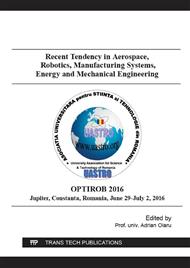[1]
A. Olaru, S. Olaru, L. Ciupitu, Assisted research of the neural network by bach propagation algorithm, OPTIROB 2010 International Conference, Calimanesti, Romania, The RPS Singapore, Book, 2010. ISBN 978−1−4244−8867−4, pp.194-200.
Google Scholar
[2]
J. SKAŘUPA, P. ZELINA: Hlavice priemyselných robotov. Ostrava 1993: 100str. ISBN 80-7078-210.
Google Scholar
[3]
L. Páchniková, R. Jánoš, Ľ. Šidlovská Manufacturing systems suitable for globalized market. In: Applied Mechanics and Materials. Vol. 282 (2013), ISSN 1660-9336, pp.230-234.
DOI: 10.4028/www.scientific.net/amm.282.230
Google Scholar
[4]
O. Staš, M. Tolnay, D. Kravec, M. Bachratý, Jedinák, Michal: Robotic manipulation system with adaptive effector reflecting different steel plate diffraction analyzed by machine vision algorithms. In: MM Science Journal. - ISSN 1803-1269(P). - Special Edition: Proceedings of the RAAD 2011. 20th International Workshop on Robotics in Alpe-Adria-Danube Region (RAAD), October 5-7, 2011, Brno, Czech Republic. - , 2011, pp.78-83.
DOI: 10.1109/raad.2010.5524538
Google Scholar
[5]
A. Olaru, A. Oprean, S. Olaru, D. Paune, Optimization of the neural network by using the LabVIEW instrumentation, IEEE ICMERA 2010 Proceedings, ISBN 978-1-4244-8867-4, IEEE catalog number CFP1057L-ART, pp.40-44, (2010).
DOI: 10.4028/www.scientific.net/amr.463-464.1011
Google Scholar
[6]
J. Semjon, V. Baláž, M. Vagaš: Robotized cell for spot welding with robot KUKA. In: OPTIROB 2007. Bren Publishing House, ISBN 9789736486562, pp.215-218.
Google Scholar
[7]
M. Vagaš, J. Semjon, M. Hajduk, L. Páchniková, M. Lipčak: The view to the current state of robotics. In: Optirob 2011: International proceedings of computer science and information technology : International konference on optimalization of the robots and manipulatos : Vol. 8, Sinaia- Romania. - Singapore: IACSIT press, 2011, ISSN 2010-460X, pp.205-209.
Google Scholar
[8]
P. Tuleja, Ľ. Šidlovská, M. Hajduk: Efector Mechanism with unilateral gripping. In: TIAM - Technologia i automatyzacja montażu. No. 1 (2013), ISSN 1230-7661, pp.14-20.
DOI: 10.4028/www.scientific.net/amm.332.181
Google Scholar
[9]
http: /www. emsyst. eu/tenzometre/default. html.
Google Scholar


